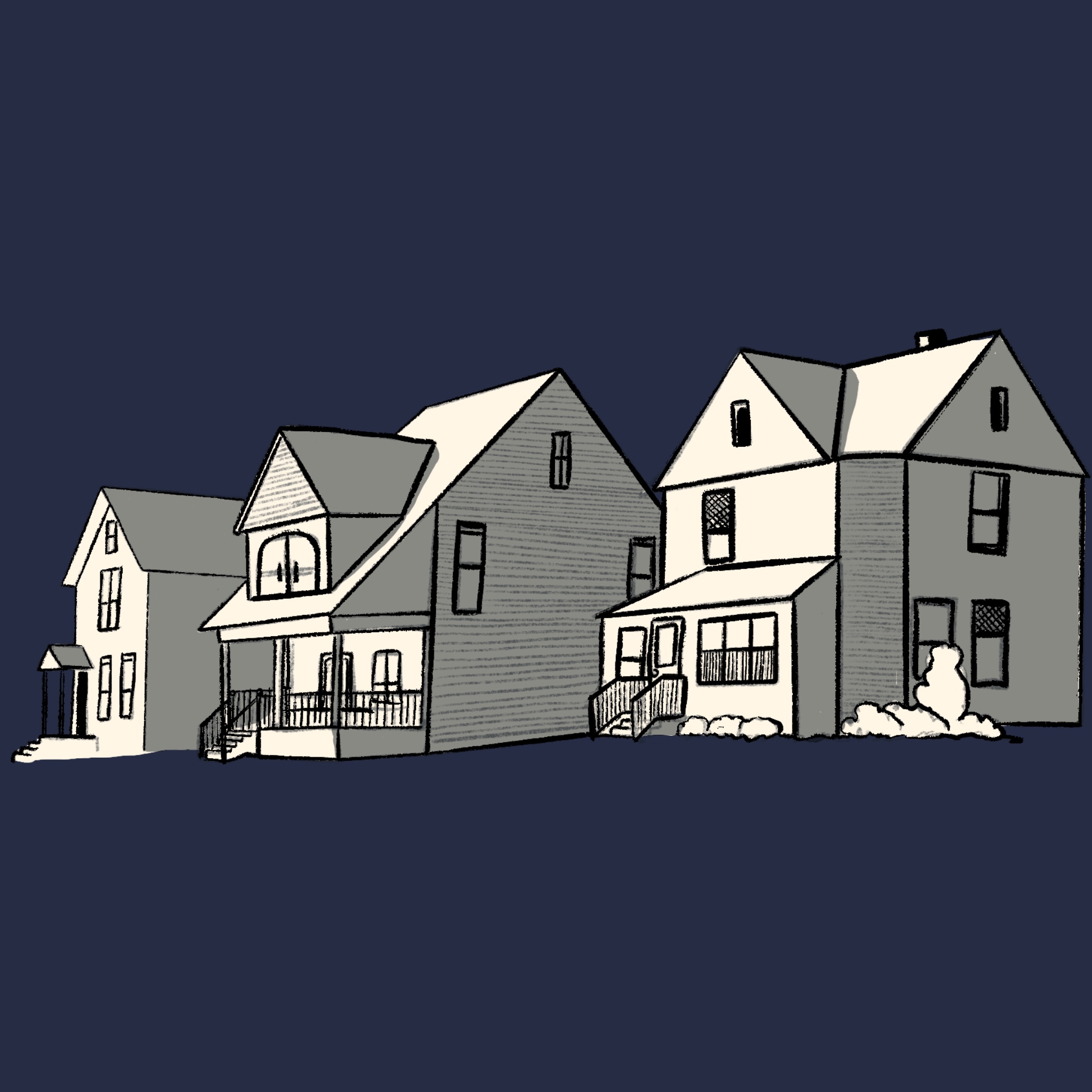Like many communities, Louisville in Jefferson County, Kentucky is racially segregated, despite growing more diverse during the past 30 years. In 2020, a fifth of Black Jefferson County residents lived in neighborhoods that were more than 75% Black, while half of white residents lived in mostly white areas.
Louisville’s Black and Hispanic residents are more likely to live in west Louisville and east of the Louisville Muhammad Ali International Airport, areas that have higher rates of poverty and use of public assistance, according to the Metropolitan Housing Coalition’s annual report published in December. Tony Curtis, executive director of the coalition, said residents in these areas are most impacted by both housing issues and climate disasters.
“We have a very old housing stock,” he said, “and the big question that drove this report is what happens when catastrophe strikes? Where are people displaced to when we are already in a severe housing shortage in this community?”
Curtis said that rural Kentucky residents usually seek homes in urban areas after a natural disaster causes displacement. But cities like Louisville and Lexington “are already facing a housing crisis,” he said. “What’s the answer?”
More than 18 million rental units in the United States are in areas at substantial risk of climate hazards like wildfires, floods and hurricanes, according to a January report from the Joint Center for Housing Studies of Harvard University.

According to the study, 41% of occupied rental homes are in places with substantial climate change or weather risks, based on annual losses for such events as calculated by the Federal Emergency Management Agency (FEMA).
About 3.2 million units with rents below $600 are in at-risk areas, the report said.
“The supply of low-rent units has been falling in the last decade,” said Sophia Wedeen, research analyst for the Joint Center for Housing Studies. “So any losses from this will reduce the number of places that low-income renters can afford to live.”
In 2023, climate disasters displaced an estimated 2.5 million Americans, according to the US Census Bureau.
When natural disasters hit, communities often see rent hikes and a spike in evictions. Meanwhile, homeowners face higher costs to repair, rebuild and insure their properties.
Low-income communities of color are most vulnerable to climate disasters or connected events, like power outages. Some neighborhoods of color still lack essential infrastructure to prevent climate hazards like flooding.
A way to visualize where resources are most needed to address climate risks
Last year, the Environmental Defense Fund and Texas A&M University developed a tool to help communities increase their climate change resilience. The climate vulnerability index ranks states and individual census tracts using two types of data: climate change risks and a community’s baseline resilience, or its ability to take on stressors from climate change.
The community baseline measure reflects social inequities and includes data on health, housing and economic factors.
[ Read more: A record number of renters couldn’t afford housing in 2022, a new study finds ]
Weihsueh Chiu, a Texas A&M professor who led the university’s work on the index, compared a community’s resilience to a person’s health. Someone with pre-existing conditions might have a harder time than others recovering from an illness like a virus.
“Similarly with communities,” Chiu said, “if they have poor infrastructure, a lot of environmental pollution, and they’re already dealing with all these different stressors, then climate change is going to make them have less reserve capacity to deal with new stressors.”
Some parts of the country, especially the South, have both high climate risk and low baseline resilience.
“One thing we found was that climate risks tend to have a bigger geographic distribution, in that going one block over isn’t going to really change your climate risk a lot,” Chiu said. “But going one block over, in some cases, can change all these baseline factors, especially socioeconomic issues, a lot.”
Places with frequent disasters have higher rents
Renters tend to have fewer assistance options than homeowners after a natural disaster, and relief programs tend to give more funds to homeowners.
One example is assistance from Community Development Block Grants for Disaster Recovery, a US Department of Housing and Urban Development (HUD) program that gives states and local governments funds to rebuild and recover after disasters. A HUD analysis found the program spent about $3 billion on affordable rental construction and rent assistance from 2006 to 2015. In the same timeframe, homeowners received $13.6 billion.
[ Read more: Why debt can make it harder to find housing in Oklahoma ]
Eric Hallett, statewide coordinator of housing advocacy for Legal Aid Services of Oklahoma, said renters typically receive assistance for relocation, while homeowners are eligible for funds to make repairs or rebuild.
“Often we see units that are already in poor conditions, and the owner’s not making repairs,” Hallett said. “Then they get that disaster money, and they still don’t make repairs, or they’ll make the repair and oust the tenant because the unit’s now worth more than it had been when it was in poor condition.”
People who are renting to own sometimes miss out on disaster assistance, too.
“They’ll only give the money to the person who’s on the deed,” Hallett said, “so you’ll see the deedholder pocket the money and the person purchasing is still without repairs.”
Rents usually rise after a disaster. A recent report from the Georgia Institute of Technology and Brookings Institution examined large metro rental markets in Arkansas, California, Florida, Georgia and Michigan from 2000 to 2020. The researchers found rents rose by 4 to 6% during the first three years after a disaster. Additional disasters caused more rent increases, and in high-risk areas that often experience a series of disasters, rents are 12% higher on average, the report said.
“If the rent’s really high in an area, those tenants might already be cost-burdened and in a vulnerable position,” Hallett said. “Then if rent goes up a little because of the lack of housing stock, people being displaced and needing to move, people just can’t sustain the rent anymore, and so it causes more people moving out, more evictions.”
Brittanny Gomez, an attorney and disaster benefits team manager for Texas RioGrande Legal Aid, said after a natural disaster, evictions are one of the first legal issues her office sees.
[ Read more: In Knoxville, a new apartment owner wants to double the rent. Some renters worry they’ll become homeless. ]
Another common problem is not having the proof of homeownership required for most aid programs.
Gomez said after disasters like Hurricane Harvey, assistance programs through nonprofits, the Texas General Land Office’s homeowner assistance program and other sources require recipients to prove homeownership.
Gomez said in her service area, properties may have multiple owners or have been passed down through generations without a proper deed transfer.
“We spend a lot of time going back, clearing up that title and filing lawsuits if we have to, to get the title clear in order to qualify them for those programs,” Gomez said.
Codes, zoning and other ways to protect housing
In 2020, a FEMA study found that hazard-resistant building codes saved $1.6 billion in damages, but most local governments don’t have modern codes that can reduce risk from certain natural disasters.
A study from Texas A&M University found that homes built to the International Residential Code after 2003 in Texas and Florida received less damage from weather events than older homes.
During Hurricanes Harvey and Irma in 2017, homes built to the code received less damage to walls, roofs and windows.
Communities can also use zoning to prepare for climate change.
A new Washington state law requires cities to allow developers to construct more multifamily housing. Cities with 25,000 to 75,000 residents must allow duplexes in all residential areas and fourplexes near major public transit stops, parks and schools. Cities with more than 75,000 residents must allow fourplexes in any residential area and six-plexes near transit stops, parks and schools.
[ Read more: A Knoxville landlord pressured a local news station to remove an article about a steep rent hike, email shows ]
Dave Andersen, managing director of the growth management program for the Washington State Department of Commerce, said having more multifamily housing helps reduce greenhouse gas emissions because it allows communities to be more compact, giving residents the option to walk or ride a bike to nearby destinations.
Andersen said: “This is an example of an opportunity where we have two converging crises—both the affordability crisis and the climate crisis—and we have an opportunity to actually attack both of those problems simultaneously if we’re smart about it.”
Like the pandemic, extreme weather often forces people to spend more time in their homes, potentially exposing them to toxins like lead or carbon monoxide. Public health experts predicted children’s lead exposure would increase during covid shutdowns, but during the pandemic, lead screenings decreased, making the picture less clear.
A 2022 study in the Journal of Pediatric Health Care examined lead screening at a clinic in Connecticut. Researchers found the screenings fell dramatically during the pandemic, and patients had a higher proportion of tests with elevated lead levels.
Another example is the 2021 winter storm in Texas that knocked out power to 4.5 million homes and businesses. As people turned to unsafe heating sources during the lengthy outage, at least 246 people died, according to the state. A BuzzFeed News analysis estimated the loss was closer to 750 lives.
“We’re going to be spending more time inside of those home environments, so it’s even more important to make sure that what we’re being exposed to on that side is safe,” said Amanda Reddy, executive director of the National Center for Healthy Housing.
Last year, Washington Gov. Jay Inslee signed into law a measure that requires cities and counties to include climate risks in their strategic plans. The law requires the plans to include policies to address climate preparedness and recovery, as well as greenhouse gas emissions.
[ Read more: As corporate landlords drive up Tennessee rents, tenants say their homeownership dreams are slipping away ]
In December, the Washington State Department of Commerce issued a guide to local governments on building climate planning into their strategies.
While planning for climate change, Andersen recommends communities use current data to develop infrastructure and focus more on taking care of their existing urban footprint than expanding it. He also suggests communities know which areas are their most vulnerable.
“Make sure that if your community’s growing that you’re directing that growth to areas that are less vulnerable, so you don’t make the problem worse,” Andersen said.
Connect with resources mentioned in this story
- Look up your community in the climate vulnerability index from the Environmental Defense Fund and Texas A&M University
- Read the Washington State Department of Commerce’s guide on climate planning
- Learn more about Texas RioGrande Legal Aid, how to apply for legal help and how to volunteer
- Learn more about Legal Aid Services of Oklahoma, how to apply for help and how to volunteer
- Learn more about the Metropolitan Housing Coalition in Louisville, Kentucky and read its annual report
- Read the Joint Center for Housing Studies of Harvard University’s 2024 rental housing report
- Read the National Center for Healthy Housing’s emergency preparedness resources on wildfires, extreme temperatures and other climate and weather disasters
Contact Streetlight editor Mollie Bryant at 405-990-0988 or bryant@streetlightnews.org. Follow her reporting by joining our newsletter.
Streetlight, previously BigIfTrue.org, is a nonprofit news site based in Oklahoma City. Our mission is to report stories that envision a more equitable world and energize our readers to improve their communities. Donate to support our work here.



